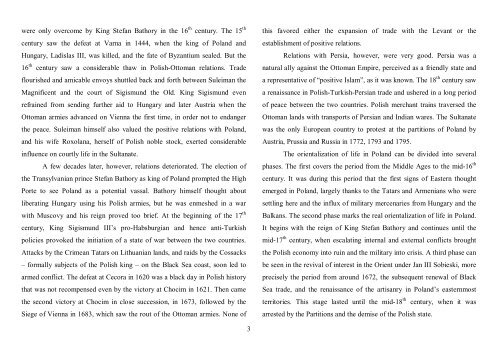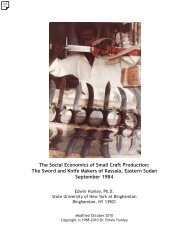Eastern Influences on Polish Arms (pdf) - Medieval Sword
Eastern Influences on Polish Arms (pdf) - Medieval Sword
Eastern Influences on Polish Arms (pdf) - Medieval Sword
You also want an ePaper? Increase the reach of your titles
YUMPU automatically turns print PDFs into web optimized ePapers that Google loves.
were <strong>on</strong>ly overcome by King Stefan Bathory in the 16 th century. The 15 th<br />
century saw the defeat at Varna in 1444, when the king of Poland and<br />
Hungary, Ladislas III, was killed, and the fate of Byzantium sealed. But the<br />
16 th century saw a c<strong>on</strong>siderable thaw in <strong>Polish</strong>-Ottoman relati<strong>on</strong>s. Trade<br />
flourished and amicable envoys shuttled back and forth between Suleiman the<br />
Magnificent and the court of Sigismund the Old. King Sigismund even<br />
refrained from sending further aid to Hungary and later Austria when the<br />
Ottoman armies advanced <strong>on</strong> Vienna the first time, in order not to endanger<br />
the peace. Suleiman himself also valued the positive relati<strong>on</strong>s with Poland,<br />
and his wife Roxolana, herself of <strong>Polish</strong> noble stock, exerted c<strong>on</strong>siderable<br />
influence <strong>on</strong> courtly life in the Sultanate.<br />
A few decades later, however, relati<strong>on</strong>s deteriorated. The electi<strong>on</strong> of<br />
the Transylvanian prince Stefan Bathory as king of Poland prompted the High<br />
Porte to see Poland as a potential vassal. Bathory himself thought about<br />
liberating Hungary using his <strong>Polish</strong> armies, but he was enmeshed in a war<br />
with Muscovy and his reign proved too brief. At the beginning of the 17 th<br />
century, King Sigismund III’s pro-Habsburgian and hence anti-Turkish<br />
policies provoked the initiati<strong>on</strong> of a state of war between the two countries.<br />
Attacks by the Crimean Tatars <strong>on</strong> Lithuanian lands, and raids by the Cossacks<br />
– formally subjects of the <strong>Polish</strong> king – <strong>on</strong> the Black Sea coast, so<strong>on</strong> led to<br />
armed c<strong>on</strong>flict. The defeat at Cecora in 1620 was a black day in <strong>Polish</strong> history<br />
that was not recompensed even by the victory at Chocim in 1621. Then came<br />
the sec<strong>on</strong>d victory at Chocim in close successi<strong>on</strong>, in 1673, followed by the<br />
Siege of Vienna in 1683, which saw the rout of the Ottoman armies. N<strong>on</strong>e of<br />
3<br />
this favored either the expansi<strong>on</strong> of trade with the Levant or the<br />
establishment of positive relati<strong>on</strong>s.<br />
Relati<strong>on</strong>s with Persia, however, were very good. Persia was a<br />
natural ally against the Ottoman Empire, perceived as a friendly state and<br />
a representative of “positive Islam”, as it was known. The 18 th century saw<br />
a renaissance in <strong>Polish</strong>-Turkish-Persian trade and ushered in a l<strong>on</strong>g period<br />
of peace between the two countries. <strong>Polish</strong> merchant trains traversed the<br />
Ottoman lands with transports of Persian and Indian wares. The Sultanate<br />
was the <strong>on</strong>ly European country to protest at the partiti<strong>on</strong>s of Poland by<br />
Austria, Prussia and Russia in 1772, 1793 and 1795.<br />
The orientalizati<strong>on</strong> of life in Poland can be divided into several<br />
phases. The first covers the period from the Middle Ages to the mid-16 th<br />
century. It was during this period that the first signs of <str<strong>on</strong>g>Eastern</str<strong>on</strong>g> thought<br />
emerged in Poland, largely thanks to the Tatars and Armenians who were<br />
settling here and the influx of military mercenaries from Hungary and the<br />
Balkans. The sec<strong>on</strong>d phase marks the real orientalizati<strong>on</strong> of life in Poland.<br />
It begins with the reign of King Stefan Bathory and c<strong>on</strong>tinues until the<br />
mid-17 th century, when escalating internal and external c<strong>on</strong>flicts brought<br />
the <strong>Polish</strong> ec<strong>on</strong>omy into ruin and the military into crisis. A third phase can<br />
be seen in the revival of interest in the Orient under Jan III Sobieski, more<br />
precisely the period from around 1672, the subsequent renewal of Black<br />
Sea trade, and the renaissance of the artisanry in Poland’s easternmost<br />
territories. This stage lasted until the mid-18 th century, when it was<br />
arrested by the Partiti<strong>on</strong>s and the demise of the <strong>Polish</strong> state.



